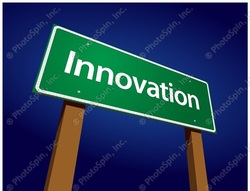
I go running every morning. I have this usual running route I follow and I have a pedometer to know how many miles this route is. However, I do not always follow the same route all the time. I tend to wander to the other streets I come across along the usual route. I like it because I see a different neighborhood or two along the way before going back to the usual route. At times, I get bored with the houses and found my way to different parks I have discovered going through some of the side streets along my usual path. Doing this, I have discovered different routes to take other than my usual path on the way back home. I see discovering these new path leading to different places as an opportunity. How you say? Well, take my usual route. All I can do there is run or walk and that is pretty much it. Now take the route leading to the parks I have discovered, there I can do anything. Not just run, walk but I saw this grassy spot near the amphitheater where I can do yoga. There are metal rails where I can do some arm exercises with a pilates band. Then my favorite of all, they have steps where I can run up and down and exercise my glutes and legs. This is why I think exploring and discovering new paths it is an opportunity. You can apply this at work too. Ever been in a brainstorming session/meeting? Is it not that looking for different paths part of brainstorming sessions? You have your usual processes or things you are currently doing now. You analyze if they are working or not and then figure out how to improve them or what actions to take. Then you have to figure out new initiatives other than the ones you currently have in place. You explore, you discover. Then you draw out the pros and cons, you compare the initiatives to what is existing now. Then you take action steps on whichever way you decide to go or do. As long as you allow yourself to explore, the possibilities are endless. The solutions are out there. So go ahead and explore and see what your explorations will show you.

I was attending a bible class one morning and they were talking about all that is happening in the world today. Moral standards declining, natural disasters etc. The question put out was is God punishing us. Do not get me wrong here, this blog is not leaning towards a religious discussion at all, so bear with me. The view on this is no, He is not. It was pointed out that there is an order to things. Like there is a reason why it needs to rain sometimes etc..etc.. To me, I think that as humans we tend to fall into a state of complacency sometimes, that we need to be shaken up, snap out of it and start thinking again. We need that from time to time. Otherwise, we will just stay in the complacency rut and...rot. Complacency happens at work almost always. Say for example in our work performance. When we were a newbie – we were excited about working. We had all the energy to keep a whole town running so to speak. It goes on for weeks, months then after a year or so, it tends to dwindle to a standstill. We tend to fall into a comfortable state that when our performance is observed it can only be rated as average. This is what I call a complacency state. We become so comfortable with how we are doing our work that it becomes our comfort zone and we stay there. Being comfortable with your work is fine but if it means not being open-minded that we can do better or be the best then you need to rethink how you are currently doing in terms of your work performance. Do you want to stay just average? Or would rather go above and beyond? Excellent even! Those performance ratings at work do have meaning and impact. If they did not, why have them in first place? It not only tells you how you have improved over the months or years but reflects what your attitude is about your performance. It tells you what you are aiming for and I hope it is not just to be average. A person can do more, be more. It all starts if you are allowing yourself to be in a complacent state and permanently stay in that state and as we said – rot in that state. Or you can choose to breeze through the complacency stage and move forward and keep on moving forward to the excellent stage – where you belong.

Creativity does not only refer to aesthetic careers. It can be found and used in any career you are in. If you are like me, in the training and development/learning and performance industry, creativity is a must! When you are responsible for training people to learn a lot of information and system navigation and have been doing this awhile, you would definitely know that you cannot teach these things in the same way over and over and over again. You need to be creative in teaching these things not only to escape being labeled the ‘boring facilitator’ but most importantly, to assist you in handling and adjusting your way of teaching in accordance to your learners. I remember when I used to teach product and services training to new hires. I had to think of ways to make teaching products and services in an interesting way so I will not make the trainees fall asleep. Whether it was telling a story based on my experience regarding the product or service to making a game out who gets to find the information fastest when we had the systems navigation training. Whatever you can think of to stimulate the interest of your learners and at the same time learning what they need to learn that is what you call creativity at work. As a training professional, painting the picture in your learners’ minds is the key. Making that picture stay in their minds is a challenge. If you continue to run your training program in the usual non-descript manner, you will end up boring your learners – or worse, doze them off to never, never land. Remember that when you facilitate a training program, you need to have two goals in mind. The first one is to make sure to capture the interest of your learners. If you have no interest in what you are teaching, how would you expect your learners to be interested in it? This is where your creativity comes in. You need to spark, keep and hold their interest from start to end. The second goal you need to be aiming for is for your learners to have a take-away from the training. What is a training program without a take-away once they are through attending it, right? In any training you facilitate, you need to know that your learners will have some learning to get out from it. Otherwise, you just wasted not only your time and effort but theirs as well. The take-away is the purpose of training. If you have not identified a purpose from the very beginning when you were designing your program, then you know you will not have take-away. People learn the information better when they are stimulated, when they have hands-on experience. When they learn something in a creative way, the information they are learning sticks and thereby, they learn it, they remember it. Find ways to be creative at work. If you want your learners to have unforgettable take-aways then challenge yourself to make your training a fun, creative, stimulating experience for them.

Ever had one of those days when you have to figure out what you can cook or make with whatever you have in the refrigerator and pantry? Added challenge is when you are in-between paydays or you just do not feel like going to the store so you need to use whatever is around and available in the kitchen. I have had many of those days and not only in the kitchen but also at work, where the art of resourcefulness comes to play. Working with what is available to you can be a real challenge at times. It can be frustrating but challenging. After much hair-pulling (yours, I hope, not some other's hair) on your part, that is, you then discover a whole new set of skills you never thought you had. With being resourceful comes the three Fs: Flexible, Fearless and Focus. Flexible: The mere fact that you are being challenged to produce something out of limited resources is a quite feat, right? I think that takes a lot of flexibility on your part to take stock of the existing inventory in your basket and figure out how you can use to create something viable. Fearless: The fact that you accepted the challenge to begin with takes a lot of courage. Forging onward with the challenge and finishing it to the end despite setbacks and other obstacles you may have faced definitely earns you a well-deserved Braveheart badge. Focus: There is nothing like a great challenge to help you get focus. Procrastination is thrown out the window while Concentration take its place. Innovativeness is born. At work, I have been in situations where there is very little or almost no resources available of what is asked of me to produce. I do not remember much of how I got through it but what I can tell you is I was flexible, fearless and focused all the way. If you are in my profession, you not only have to be but need to be. Making do with what you have at hand is one of the greatest personal achievement you can be proud of, whether it is at work or in the kitchen. What is even more impressive (and you would probably surprise yourself!) is that what you came up with showcases your innovativeness. So go ahead, take the challenge unflinchingly and embrace your innovativeness.

Sometimes you cannot exactly pinpoint what training your staff needs. I have had several opportunities where I needed to help clients figure out what their teams' training needs are. I have been faced with situations where the operations supervisor thinks the operations staff needed a certain kind of training and the quality supervisor says otherwise. Sometimes we may not see eye-to-eye what training our team really needs until we ask a third party to observe and give their own conclusion. There is nothing wrong with that. It actually helps asking someone to look at things with their own eyes. Almost always, you will realize that you missed out on a couple of things you had not observed before. I always say 'fresh eyes gives a new perspective'. Realize that we cannot always look at things from the same viewpoint. We have to train ourselves to look at each angle when it comes to solving a problem. When I am asked to observe for training needs for a group of people, I look at all angles. You cannot generalize a training need. Say for example, your team has problems with communication, therefore they need a communication skills training. My reply to you then, would be, 'which areas are they having problems with?' You need to break it down. I guarantee you that not everyone has the same problem. Some could have grammar problems, some perhaps, tone of voice, some enunciation and so and so forth. If you know which area or component to target, you will be able to help your team improve themselves. Another situation I have encountered as a consultant is when the client would conclude that the solution to their problem is training and yet, when, we proceeded training needs analysis, the conclusion is that it it not a training problem but say, an operations issue or management issue and so on and so forth. If you are ever on a spot where you know there is an issue with your team, do the following: 1) Look at it at all angles; 2) Get some fresh eyes to look at it; and 3) To find out if training is the answer or not, observe, ask questions, do a training needs analysis. Once you do all these, you will know exactly what your team needs.




